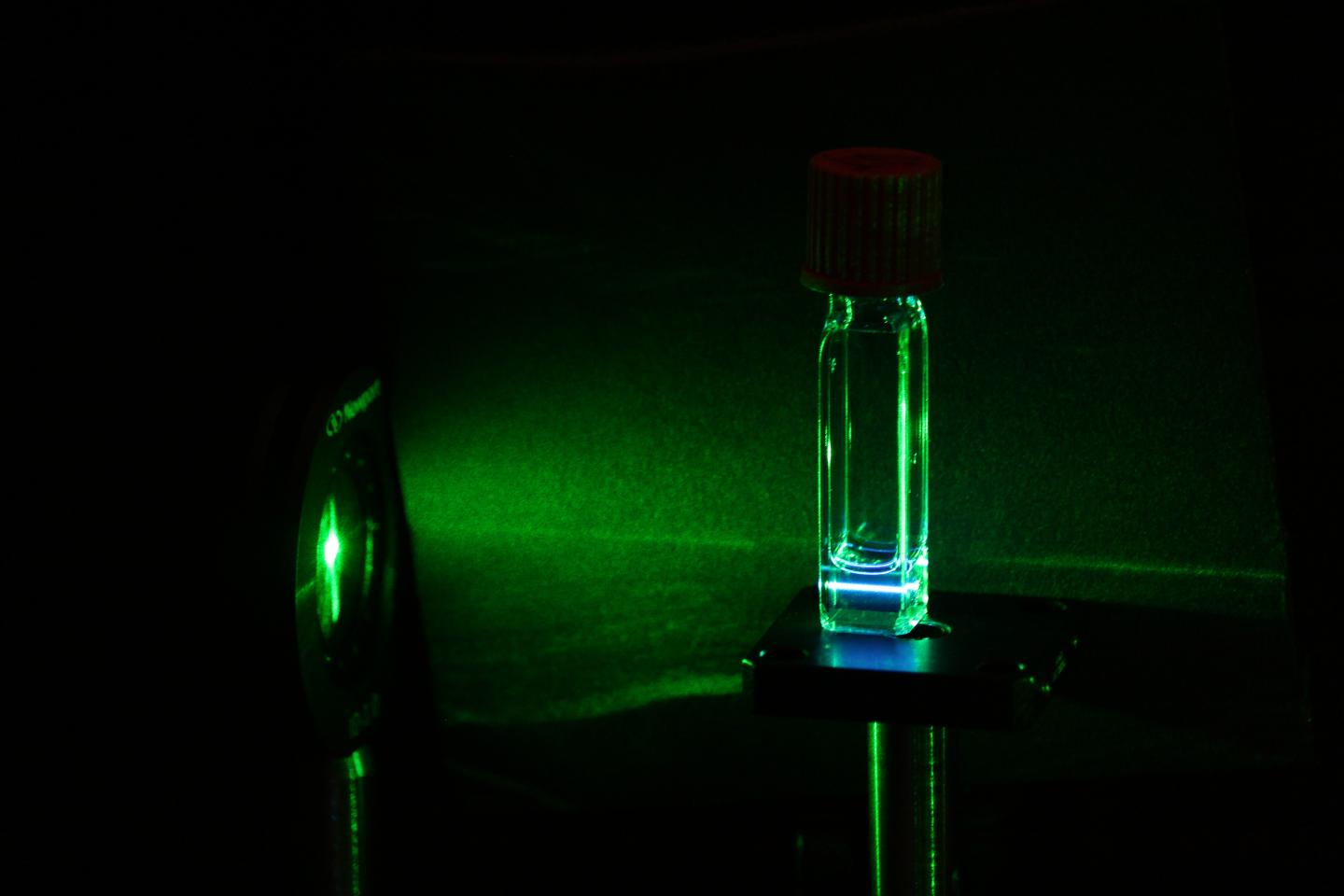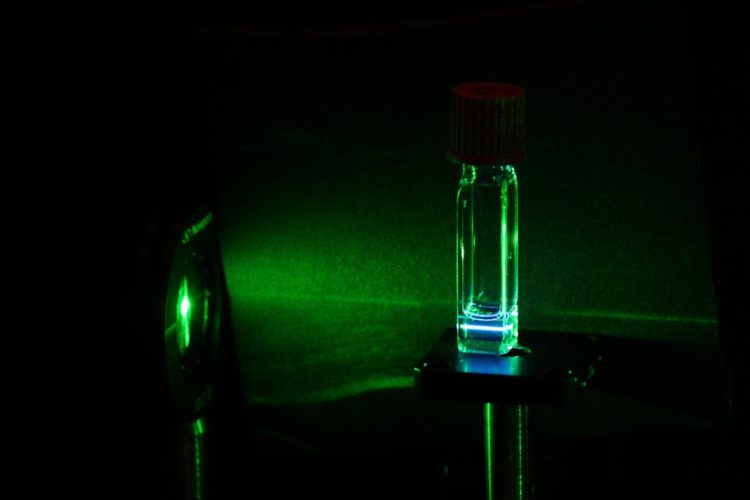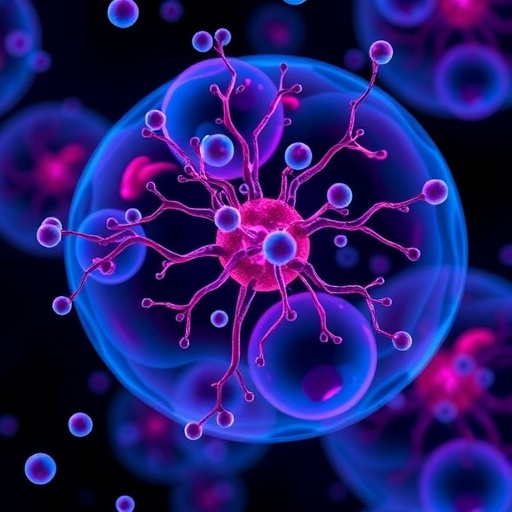Researchers use nontoxic silicon nanocrystals to convert low-energy photons into high-energy ones, bringing scientists closer to developing photodynamic treatments for cancer

Credit: Lorenzo Mangolini & Ming Lee Tang/UC Riverside
Materials scientists at the University of California, Riverside and The University of Texas at Austin have demonstrated that it is possible to achieve photon up-conversion, the emission of light with energy higher than the one that excites the material, when using carefully designed structures containing silicon nanocrystals and specialized organic molecules.
The accomplishment, published in Nature Chemistry, brings scientists one step closer to developing minimally invasive photodynamic treatments for cancer. The advance could also hasten new technologies for solar-energy conversion, quantum information, and near-infrared driven photocatalysis.
High energy light, such as ultraviolet laser light, can form free radicals able to attack cancer tissue. Ultraviolet light, however, doesn’t travel far enough into tissues to generate therapeutic radicals close to the tumor site. On the other hand, near-infrared light penetrates deeply but doesn’t have enough energy to generate the radicals.
While photon up-conversion can overcome this limitation, up-converted materials have either low efficiency or are based on toxic materials. Silicon is well-known for being nontoxic, but until now, researchers have not been able to demonstrate that silicon nanocrystals can up-convert photons, leaving this promising cancer treatment tantalizingly out of reach.
A group led by UC Riverside materials science doctoral student Pan Xia attacked this problem by carefully studying the surface chemistry of silicon nanocrystals. The group learned how to attach ligands, which help bind molecules together, to the nanoparticle that are specifically designed to transfer the energy from the nanocrystals to surrounding molecules.
The team then shined laser light into the solution. They found silicon nanocrystals with appropriate surface ligands can rapidly transfer the energy to the triplet state of surrounding molecules. A process called triplet-triplet fusion then converts the low-energy excitation to a high energy one, resulting in the emission of a photon at shorter wavelength, or higher energy, than the one originally absorbed by the nanoparticle.
“We functionalized silicon nanocrystals with anthracene. Then we excited the silicon nanocrystals and found that the energy was efficiently transferred from the nanocrystal, through the anthracene molecules, to the diphenylanthracene in solution,” said Xia. “It means we got higher-energy light.”
“To turn the low-energy photons into high-energy photons, you need to use triplets, you need to use quantum confined nanoparticles, and you need to hold the nanoparticles and the organic molecules very close together. This is how you get the triplets to combine energy to get the high energy photons,” said co-author Ming Lee Tang, an associate professor of chemistry at UC Riverside and Xia’s dissertation adviser. Tang’s lab pioneered how to attach conjugated organic molecules to the silicon nanoparticles.
“This work is very fundamental,” said co-author Lorenzo Mangolini, an associate professor of mechanical engineering, whose group made the silicon nanocrystals. “The novelty is really how to get the two parts of this structure — the organic molecules and the quantum confined silicon nanocrystals — to work together. We are the first group to really put the two together.”
Co-author Sean Roberts, an assistant professor of chemistry at The University of Texas at Austin, used ultrafast lasers to investigate how energy is transferred in this hybrid structure, and determined the process is both amazingly fast and efficient.
“The challenge has been getting pairs of excited electrons out of these organic materials and into silicon. It can’t be done just by depositing one on top of the other,” said Roberts. “It takes building a new type of chemical interface between the silicon and this material to allow them to electronically communicate.”
The discovery could also lead to improved photocatalysis, which uses light to drive chemical reactions.
“Photocatalysts generally only work with ultraviolet light or violet light, so this is a way to generate that from the rest of the solar spectrum,” Tang said.
The environmentally sustainable silicon-centered approach is also relevant for quantum information science and singlet fission-driven solar cells.
###
The paper, “Achieving spin-triplet exciton transfer between silicon and molecular acceptors for photon upconversion,” was published Dec. 2 in Nature Chemistry. Other authors include Emily K. Raulerson, Devin Coleman, and Carter S. Gerke.
Funding for the research was provided by the National Science Foundation, the Robert A. Welch Foundation, the Research Corporation for Science Advancement, the Air Force Office of Scientific Research and the Department of Energy.
About UC Riverside
The University of California, Riverside is a doctoral research university, a living laboratory for groundbreaking exploration of issues critical to Inland Southern California, the state and communities around the world. Reflecting California’s diverse culture, UCR’s enrollment is more than 24,000 students. The campus opened a medical school in 2013 and has reached the heart of the Coachella Valley by way of the UCR Palm Desert Center. The campus has an annual statewide economic impact of almost $2 billion. To learn more, email [email protected]>[email protected].
Media Contact
Holly Ober
[email protected]
951-827-5893
Original Source
https:/
Related Journal Article
http://dx.





